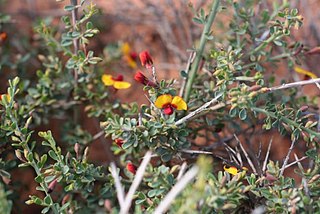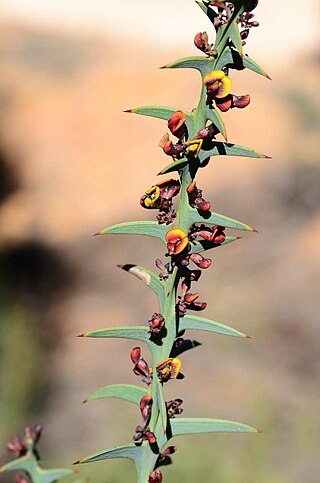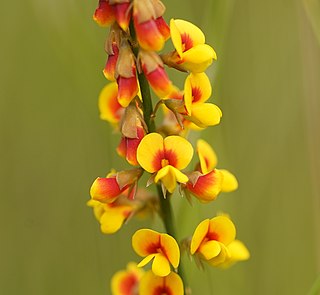
Daviesia horrida, commonly known as prickly bitter-pea, is a species of flowering plant in the family Fabaceae and is endemic to the south-west of Western Australia. It is a spreading shrub with rigid, spiny branchlets, narrowly elliptic phyllodes and orange and dark red flowers.

Sphaerolobium is a genus of flowering plants in the family Fabaceae and is endemic to Australia, occurring in all states and territories except the Northern Territory. Species of Sphaerolobium are erect shrubs, usually with rush-like stems and yellow or red flowers similar to others in the family.

Daviesia brevifolia, commonly known as leafless bitter-pea, is a species of flowering plant in the family Fabaceae and is endemic to the southern continental Australia. It is a broom-like shrub with short, cylindrical phyllodes and apricot to reddish-brown flowers.

Bossiaea spinosa is a species of flowering plant in the family Fabaceae and is endemic to the south-west of Western Australia. It is a low, dense prostrate or rounded, twiggy shrub with egg-shaped to elliptic leaves and deep yellow to orange and pinkish-red, pea-like flowers.

Daviesia ulicifolia, commonly known as gorse bitter-pea, is a species of flowering plant in the family Fabaceae and is endemic to south-eastern Australia. It is a rigid, openly-branched shrub with sharply-pointed, narrow elliptic, narrow egg-shaped, rarely egg-shaped phyllodes and usually orange-yellow and dark red flowers.

Bossiaea aquifolium, commonly known as water bush, nedik or netic, is a species of flowering plant in the pea family Fabaceae and is endemic to Southwest Australia. It is a slender shrub or small tree with egg-shaped leaves arranged in opposite pairs and yellowish flowers arranged singly or in pairs on the ends of branchlets.
Pultenaea craigiana is a species of flowering plant in the family Fabaceae and is endemic to near Ravensthorpe in the south of Western Australia. It is an erect, spindly shrub with densely hairy young stems, egg-shaped leaves with the narrower end towards the base, and yellow and red flowers.
Bossiaea barbarae is a species of flowering plant in the family Fabaceae and is endemic to Western Australia. It is an erect, compact, spiny shrub with egg-shaped to elliptic or oblong leaves, and deep yellow and bright red flowers.

Bossiaea calcicola is a species of flowering plant in the family Fabaceae and is endemic to the far west of Western Australia. It is compact, glaucous, spiny shrub with oblong, wedge-shaped or round leaves and bright yellow, reddish and greenish-yellow flowers.

Bossiaea ornata, commonly known as broad leaved brown pea, is a species of flowering plant in the family Fabaceae and is endemic to the south-west of Western Australia. It is a shrub with variably-shaped leaves, typically egg-shaped or oblong, and yellow or orange-yellow and reddish-brown flowers.
Bossiaea spinescens is a species of flowering plant in the family Fabaceae and is endemic to the south-west of Western Australia. It is a slender, spreading or compact, spiny shrub with oblong to oval leaves and yellow and reddish-brown, pea-like flowers.

Daviesia arenaria, commonly known as sandhill bitter-pea, is a species of flowering plant in the family Fabaceae and is endemic to south-eastern continental Australia. It is usually a hummock-forming shrub with many short, spiny branchlets and heart-shaped to elliptic phyllodes with a sharp point on the end, and orange-pink, maroon and yellow flowers.
Hovea corrickiae, is a species of flowering plant in the family Fabaceae and is endemic to south-eastern Australia. It is a shrub or slender tree with densely hairy branchlets, narrowly egg-shaped or elliptic, dark green leaves with stipules at the base, and mostly pale to deep mauve, pea-like flowers.

Daviesia laevis is a species of flowering plant in the family Fabaceae and is endemic to the Grampians in Victoria, Australia. It is an open, erect shrub with arching branchlets, scattered narrow elliptic to linear phyllodes and orange-yellow and brownish-red flowers.

Daviesia pectinata, commonly known as thorny bitter-pea, is a species of flowering plant in the family Fabaceae and is endemic to south-eastern continental Australia. It is a dense, rigid shrub with erect, flattened branchlets, crowded, flattened, triangular phyllodes, and yellow to orange and reddish flowers.

Daviesia physodes is a species of flowering plant in the family Fabaceae and is endemic to near-coastal areas of south-western Western Australia. It is an open shrub with vertically flattened or tapering, sharply-pointed phyllodes, and yellow and pink to red flowers.

Daviesia sejugata is a species of flowering plant in the family Fabaceae and is endemic to southern Australia. It is a straggling, mostly glabrous shrub with spiny, ridged branchlets, scattered, sharply-pointed, narrowly elliptic phyllodes, and yellow, maroon, orange and dark purple flowers.

Sphaerolobium minus, commonly known as globe-pea, is a species of flowering plant in the family Fabaceae and is endemic to south-eastern Australia. It is an erect, rush-like, mostly leafless shrub with yellow and reddish flowers arranged in small groups along the stems.
Sphaerolobium pubescens is a species of flowering plant in the family Fabaceae and is endemic to the south of Western Australia. It is a small shrub or subshrub with slender stems, tapering linear leaves and dense racemes of yellow flowers.

Sphaerolobium vimineum, commonly known as leafless globe-pea, is a species of flowering plant in the family Fabaceae and is endemic to Australia. It is an erect, rush-like, mostly leafless shrub with yellow and reddish flowers arranged in small groups along the stems.















